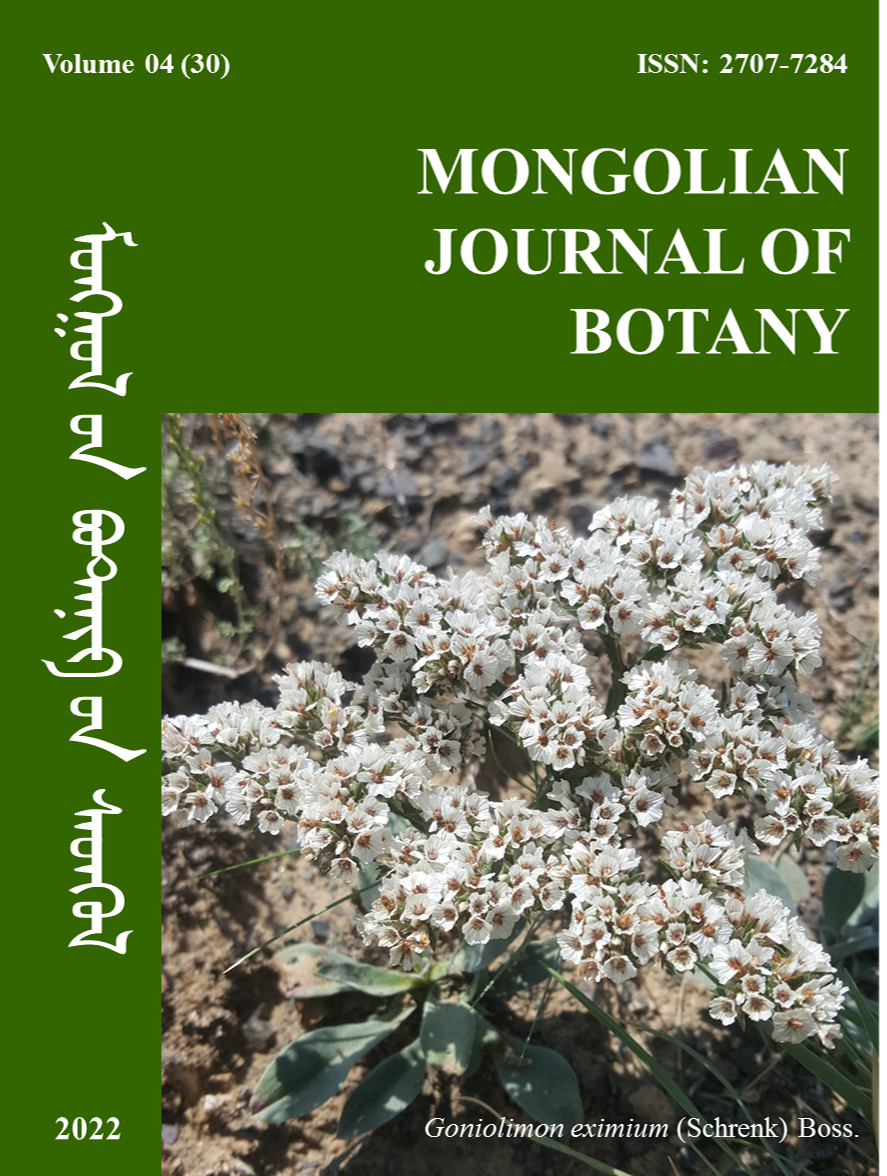Identification of the degradation of birch forests habitats by lichen species
(On the example of the mountain forest Ubugunt at the station Shatan Batsumber Sumona, Central aimag)
DOI:
https://doi.org/10.5564/mjb.v4i30.2580Keywords:
lichen species, edge forest, habitats, stumps, manure residuesAbstract
A study was conducted to determine the degradation of birch forest habitats by epiphytic lichens. As a result of research in the birch forest at the station Shatan somone Batsumbera of the Central aimag, 17 species of epiphytic lichens from 4 families and 13 genera were registered. The forest point was chosen as an example of a site with a change of primary vegetation type of larch forests from the forest of the steppe area of West Kentei. In terms of the number and diversity of species in point-of-forest studies, the number of species at the edge of the forest has decreased relative to the depth of the forest. In terms of species cover, 75% of the total species cover is Melanelia olivacea (45.8%), Physcia aipolia (18.2) and Evernia mesomorpha (11.5). At the same time we noted that the number of species and their diversity depends on the diameter of the tree trunk and the number of stumps, fallen and rotten trees.
To determine the factors influencing species richness and distribution, a comparison was made between the number of stumps (large amounts of wood harvested in the forest) and the amount of manure residues (used for grazing) in the forest habitat. As a result, it has been established that the most important factor is the manifestation of the «edge effect» in the forest as a human factor. Thus, the decline in lichen species due to the loss of habitat diversity in birch forests indicates а increase in the degradation of birch forest habitats.
Хусан ойн амьдрах орчны доройтлыг хагийн төрөл зүйлээр илэрхийлэх асуудалд
(Төв аймаг, Батсүмбэр сум, Шатан өртөө, Өвгөнт уулын ойн жишээн дээр)
Хураангуй: Хусан ойн амьдрах орчны доройтлыг хагийн төрөл зүйлээр тогтоох судалгааг явууллаа. Баруун Хэнтийн тайгархаг шинэсэн ойн ургамалжлын үндсэн хэв шинжид нь өөрчлөлт орсон газар нутгаар сонгосон Төв аймгийн Батсүмбэр сумын Шатан өртөөний Өвгөнт уулын хусан ойд 3 баг, 4 овог, 13 төрлийн 17 зүйл эпифит хаг бүртгэв. Тус ой хагийн зүйлийн тоон болон олон янз байдлын хувьд ойн захад ойн гүнээсээ багасаж, бүрхцийн хувьд нийт зүйлийн бүрхцийн 75%-ийг Melanelia olivacea (45.8%), Physcia aipolia (18.2), Evernia mesomorpha (11.5) гэх цөөн зүйл бүрдүүлсэн онцлогтой. Зүйлийн тоо, тэдгээрийн олон янз байдал модны ишний диаметрын хэмжээ, унанги болон өмх моддын тоон өсөлтөөс хамаарч байна. Зүйлийн баялаг, тэдгээрийн тархцад нөлөөлөх хүчин нөлөөг ойн амьдрах орчинд тохиолдох өсвөр моддын болон хожуул (ойгоос их хэмжээний түлшний мод бэлтгэсэн)-ын тооноос гадна аргал хомоол (малын бэлчээрт өртөгдсөн)-ын тохиолдцын тоон харьцуулалтаас үзэхэд “захын эффект” нөлөө хамгийн чухал хүчин зүйл болж буйг тогтоолоо. Ийм нөлөөнд автагдаж буй хусан ойн ургах субстратын олон янз байдал хомсдох шалтгааны улмаас хагийн төрөл зүйлийн бууралт нь ойн амьдрах орчин доройтож буйг илэрхийлж байна.
Түлхүүр үгс: хагийн зүйлийн тоо, хусан ой, шинэсэн ой, экотоп, биотоп
Downloads
269
Downloads
Published
How to Cite
Issue
Section
License
Copyright (c) 2022 Ochirbat Enkhtuya, Samya Jaavkhlan

This work is licensed under a Creative Commons Attribution 4.0 International License.
The authors grant the Mongolian Journal of Botany a license to publish the article and identify itself as the original publisher.

Articles in the Mongolian Journal of Botany are Open Access articles published under a Creative Commons Attribution 4.0 International License CC BY.
This license permits use, distribution and reproduction in any medium, provided the original work is properly cited.




